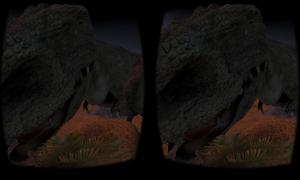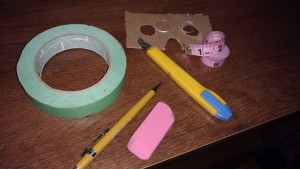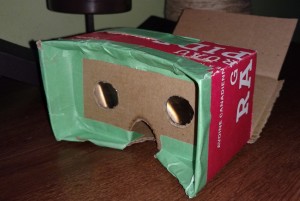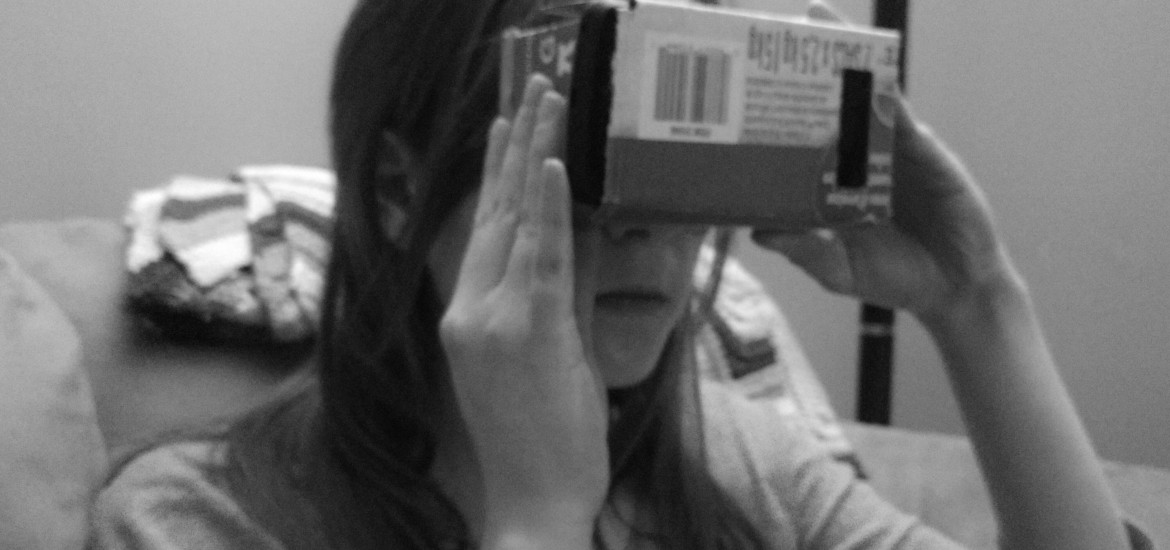Walking with dinosaurs, flying through space and even psychological treatments. Danielle Elliott takes a trip into the past, present and future of Virtual Reality. What we can realistically expect of this emerging technology? Will it isolate us from humanity or save us from ourselves? Which do we take, the red pill or the blue pill?
I sat in front a cliff face staring at the orange glow of the setting sun. Twilight had passed and stars twinkled above my head. Looking out into the distance was pure nothingness for miles. Until they came.
I sat still as two velociraptors crept into view, hoping they would pass. I almost made it. They had crossed the clearing when one turned on me suddenly. I sat there frozen, unable to run, as the beast advanced on me. But another, even more terrifying call rang out.
The raptors fled and I was spared from being ripped apart. But then, a tyrannosaurus rounded the corner of the cliff face. Watching Jurassic Park as a child taught me to stay perfectly still. Don’t even breathe. So that’s what I did.

But when its ugly snarling nose was inches from my own I knew it was too late. Its teeth were grotesque. Then it turned as if to leave. Just as I was feeling safe once more, it rounded on me. Its jaws opened wide, snapping at me. There was no way to escape. I shrieked and ripped the headset off my face.
Facebook recently purchased the Occulus Rift headset which will be shipping out at the end of the month. Samsung released Gear and HTC’s Vive will be out in April. Each typically runs around $1,000 to $2,000. The barriers to entry in VR for the masses were lower than what we could have expected decades ago, but still high.
Then, last November, the New York Times also released videos on their own channel NYTVR that can be accessed using Google Cardboard. These cardboard viewers courtesy of Google transform any cellphone with a gyroscope into your personal VR player. Viewers run between $15 and $300 if you chose to purchase one, but Google released the plans online for free. Already, the barriers were lowered and anyone willing to put in a little elbow grease could make their own viewer for under $10. The future was now.
I soared with the birds, shot lasers with my eyes in outer space, visited Third World countries, took a tour of New York and walked among lions. Still, I was underwhelmed. Despite the short VR Dinosaur Terror app, I have to admit, I was disappointed. Rationally, I know technology has not yet reached a place where we can travel to other dimensions. Still, the brand new Virtual Reality (VR) technology was anything but realistic. I wanted more. The graphics choppy and raw.
The experience was rather similar to playing Call of Duty, without dependence on a remote control. The experiences were virtual, but a far cry from reality. So where is this life changing technology we were promised and do we really want to delve that deep into unreality?
Spiders, snakes and public speaking
Imagine the offices of a new technology-based start-up business. You might be pulling up scenes from The Social Network. Geeky graduate students hyped up on energy drinks talking about how they’ll changed the world.
Now imagine the company uses virtual software to help manage stress, anxiety and depression. The image might change to people in white coats guiding patients wearing Occulus Rift or Google Cardboard glasses. A scene right out of a sci-fi movie.
CyberPsyc Solutions in Fredericton is that technology-based start-up business. Based off the research of its founder, UNB professor Darren Piercey, it develops software to guide “students” through the process of conquering their anxiety, depression and stress.
“We have a love affair for new technology and young people embrace technology,” said Piercey. “It provides them with a way of communicating with each other.”
My faith in everyday VR use was increasing, though the office would leave sci-fi fans heavily disappointed. Just your typical start-up office. A few private offices along the walls of a mostly empty room with a conference table in the middle. In the corner, a couch and television with a small break-room kitchen nearby. CyberPsyc’s three employees wore many, figurative, hats. Each holds numerous positions within the company, unfortunately for me, without wearing VR headsets.
CyberPsyc Solutions provides a comprehensive package for users including psycho-education units on how we treat anxiety, depression or phobias. They give “students” “homework” across a number of platforms. Their app MoodCheck asks users to check in and evaluate how they are feeling throughout the day. They have a digital meditation room for relaxation. They also use VR to treat phobias. As unexciting as it looked, I may have found the promised land.
“For people who are afraid of public speaking, there’s an audience full of avatars that do random things that are kind of nasty if you’re not comfortable with public speaking. Laughing, cellphones go off, people will arrive late.”
The most popular phobia-treating simulations are spiders, snakes and public speaking, according to Piercey. But my confidence in the future of virtual tech was shattered nonetheless. Early in his research, Piercey had looked into using VR headsets for the simulations, but found the technology too high priced to provide the accessibility he desired.
Right now, even the headset-free video simulations are too expensive for individual users to purchase out of pocket. As a start-up, CyberPsych Solutions have only reached a point where its software is affordable for universities or businesses to purchase. Adding the cost of headsets would just make it unfeasible.
Piercey said even without the headsets adding another dimension of realism, the software is still effective.
“I know it’s hard to believe for some people, but if you’re not afraid of spiders or you’re not afraid of snakes and you see the virtual spider you think ‘yeah it looks like a spider but I don’t get it. How can this actually scare somebody?’” said Piercey. “But when you’re genuinely afraid, people get startled by little pieces of fluff or, you know, you see a garden hose and you think ‘oh my god! It’s a snake!’”

Still, Piercey said he remains interested in the increasing affordability of VR technologies.
“The more realistic it can be, the better it’s going to work,” said Piercey. “Some research we were doing involved, at the time, some pretty expensive head-mounted displays. But it was really expensive back then… I guess even the Occulus Rift wasn’t as inexpensive as people were hoping it was going to be… but it won’t be long, I think, before it’ll be pretty standard.”
Let’s go down the rabbit hole
Our world is one of illusion. Numbers and patterns translate into everything we think we see, touch or taste. We are human batteries plugged into a machine, feeding the robots we’ve created that have taken over our world and destroyed it. Only a few humans on the fringe know the truth and see reality for what it is. To bend the rules of reality itself, first, you must choose the blue pill or the red pill.

These are the fears The Matrix instilled within us. We are doomed to spend our short lives unknowing of the real world around us and live within a fake, digital reality. One that is either a blessing or a curse, depending on how you view it.
I thought maybe it’s better this technology stays in its infancy. If not, we may be doomed to a solitary life, hooked up to machines, never knowing the difference between true contact and the fake touch we believe we feel. How will we know the true wonders of the world? How will we truly connect with one another?
Rodger Wilkie put my fears to rest. The professor of literature at St. Thomas University writes science fiction and is deeply interested in science and technology.
“There would be no humanity without technology,” said Wilkie. “If it weren’t for our hominid ancestors using stone tools, we would not have developed the bodies and brains that we did. So technology has actually shaped us from before the beginning of when we were a species. The idea of human nature outside of technology, is quite frankly absurd.”
While some might fear we’re using technology to escape reality already, for example our “addiction” to cellphones and computers, Wilkie argues a book, which has been around for centuries, can serve the same purpose. He said the only experience he can truly think of where we are completely disconnected from technology is meditation.
That being said, he understands why some would be concerned, though he calls himself an optimist. He does advise we proceed with caution when developing new technologies, like VR, but said it’s truly impossible to know what the future will hold as we live within a complex system and society. He did imagine both the best and worst case scenarios when it came to virtual reality.
“I can imagine a world in which people are so tuned out from the physical world in which they live that they completely lose touch with their bodies and live entirely in their heads. That’s not a life that I would want,” said Wilkie.
On the other hand, Wilkie worries about our use of carbon, especially in the travel and tourism sector. He said it would be nice if we didn’t kill ourselves with our taxations on the environment and thinks VR might present a better alternative.
“I wonder if, as VR technology improves and this may sound kind of weird, but that taking a virtual reality trip would be a superior alternative to taking a real trip because you’re not burning carbon.”
The idea isn’t as crazy as Wilkie may believe. The majority of VR apps to be found on Google Play are geared at virtual tours of the world. As technology advances, virtual vacations may very well be possible.
Still, Wilkie said as long as we continue to use VR constructively, for self-improvement and recreation, instead of to the detriment of others, we’ll be fine.
The future is now
As I write this, the first full-length feature film using VR has been announced. They began late last year with nothing but GoPros strapped together on rings to create a video sphere. Some high tech editing software allowed the real life footage to be stitched together to provide 360-degree viewing. Soon, we will be able to virtually sit inside a room with characters.
Sports networks are creating similar mounted cameras to provide viewers with the experience of sitting in the audience while watching a basketball game. They’re working on technology to allow our avatars to sit with our friends. We won’t be disconnected at all.

HTC’s Vive will allow us to use our artistic abilities to create entire worlds ourselves. It’s been compared to a 3D version of PC’s Paint.
While the current state of VR is far from visiting far off galaxies in a realistic fashion, we’re getting there. It’s coming for us whether we embrace it or not. But I’m hopeful the market will do its thing, and as technology advances, maybe the headsets will be more affordable. Maybe we will travel without ever stepping foot from our homes. Rather than worrying about our head space, we could rejoice that a truly connective world will soon occupy it. And maybe bring some peace to it.
Maybe I will truly walk with the dinosaurs, though hopefully by then, they will be herbivores.
